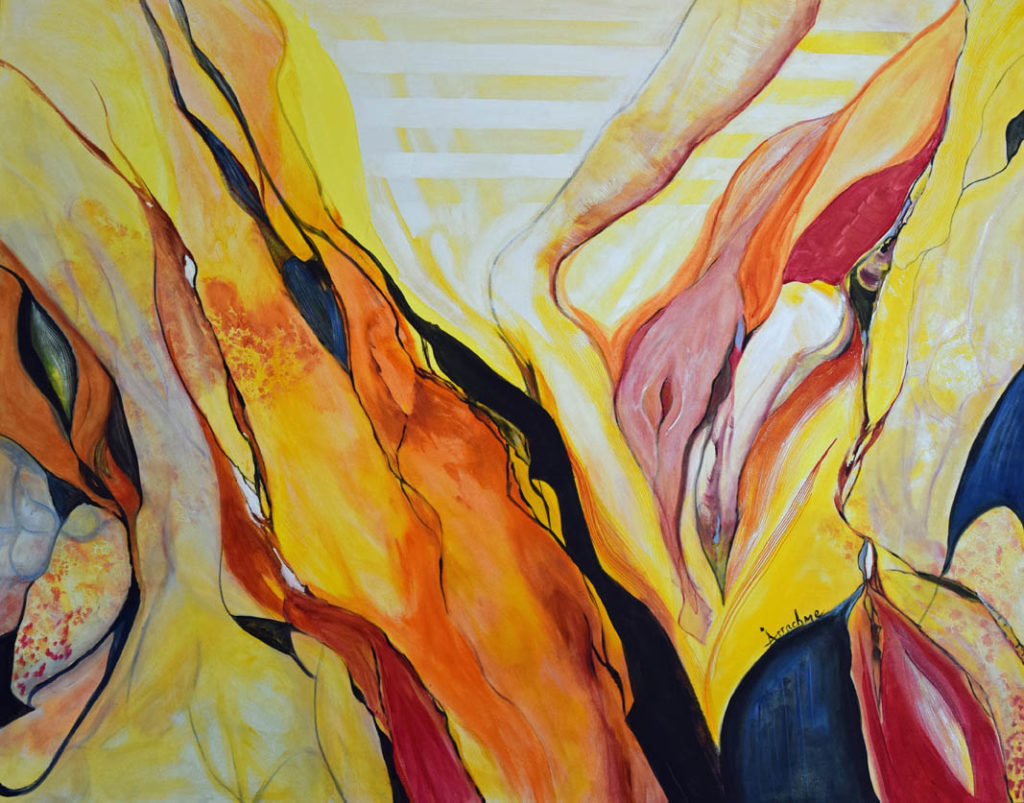Article #42 Happy Accidents
by Arrachme
Can “Happy Accidents” reveal the truth behind abstract painting? Everyone loves a good “happy accident,” right? It’s that moment when something unexpected happens. And suddenly, voila! Like magic, you’ve created something amazing. In the world of abstract painting, these happy accidents are often hailed as the key to creativity. But here is the catch: while abstract art might seem like a free-for-all of splashes and splatters, it’s anything but random.
Sure, spontaneous bursts of color can spark new ideas, but abstract painting is a precise dance between vision and skill, and understanding the difference between color, composition, and technique. Take Jackson Pollock, for example. His legendary drip paintings seem like pure chaos, yet each splash is carefully choreographed. The man knew exactly what he was doing, even if it did not look that way, at first glance.
Jackson Pollock Drips
In 2024 a breakthrough technology: the macro-X-ray. It was used to identify the painting materials that Jackson Pollock used. They were able to discover a secret behind his famous abstract expression paintings. For years art lovers wondered: Was Pollock randomly flinging paint? Turns out, not exactly. The x-ray scans revealed that he started with a drawing on some canvases. From there he splashed, poured in deliberate calculated gestures. It wasn’t just about chance, rather it was a carefully crafted process that required both skill and imagination.
Now let’s talk about the inspiring artist. Have you ever heard someone say, “This isn’t working. I’m just going to turn my painting into an abstract”? It often happens when someone is feeling stuck or frustrated, hoping abstract art is an easy way out. But let’s be clear: abstract art is not a get-out-of-jail-free card. It can be even more challenging than figurative painting. True abstract art is a fine balance between spontaneity and control – an intricate dance of creativity, technique, and emotion. It’s not about slapping paint on a canvas and calling it a day. It’s about making thoughtful choices, pushing boundaries, and embracing chaos and precision. If a modern artist wishes to paint like Mr. Pollack and gets the splattering, dripping portion exact, the painting may still feel like it is missing something. It is missing the “heart”, which is an infused combination of emotion and design skill.
Disassembling A Painting

Enclosed is my painting “Impenetrable.” It is an abstract expression on canvas, that technique-wise, might be easy to dissect. Let me help you.
- Can you see the repetitive patterns throughout using shapes to ground the painting?
- Can you see the calming diagonal lines moving through? Diagonals create movement, but at the same time, can promote a contemplative feeling of depth, similar to the feeling of being deep in a novel.
- Do you see the deliberate choice of a monochromatic color palette? This means of paint colors are in the same family. It can be used to mute the color and highlight the shapes, thus creating visual texture. Visual texture creates the illusion of texture but is flat to the touch. The monochromatic choice adds an air of sophistication to the artwork.
Discriminating Eyes
Cy Twombly’s work often challenges the viewer’s expectations, leading to comments like “What’s that?” or “My three-year-old can do that!” His abstract nonobjective paintings, particularly from the 1950s and 1960s, were not merely scribbles but deliberate expressions of emotion and history. His later aggressive mark-making was deeply connected to his experience of war. During his time in Rome, he connected a fascination with mythology and his existing emotions regarding war. An untrained eye might think his work was a combination of “Unhappy accidents.”
Twombly’s work was not about simply creating shapes or lines but rather about exploring themes of historical conflict and mythological narratives. His paintings, including the well-known “Untitled” series, are often visceral and charged with energy. These works are sometimes characterized by billowing loops of red acrylic paint, on a plain background. These red swirls and scribbles may appear spontaneous, but they were a continuation of personal and historical themes. Twombly’s paintings reflect an emotional landscape, merging abstract expression with the weight of historical memory, mythology, and personal identity.
At first glance, his art may seem like chaotic marks, but deeper understanding reveals the complex emotions and stories embedded within these nonobjective forms. His work invites the viewer to look beyond the surface, to feel the underlying tension, and to engage with the abstract language that he created. I can think of two favorite artists of mine that this definition might describe: Mark Rothko and Willem De Kooning.
So next time you see a work of abstract art, remember it’s not just a “happy accident.” It’s a masterpiece born from a deep understanding of craft, mixed with a healthy dose of risk-taking and a little magic.
